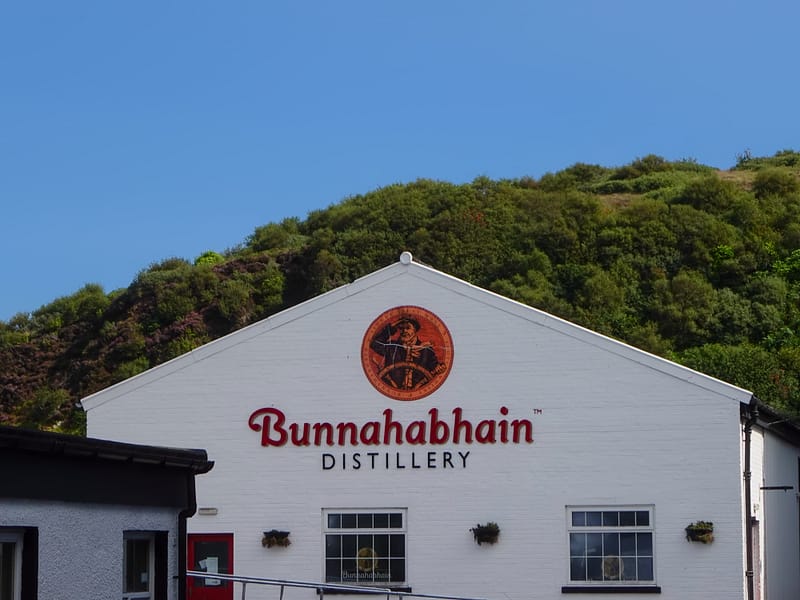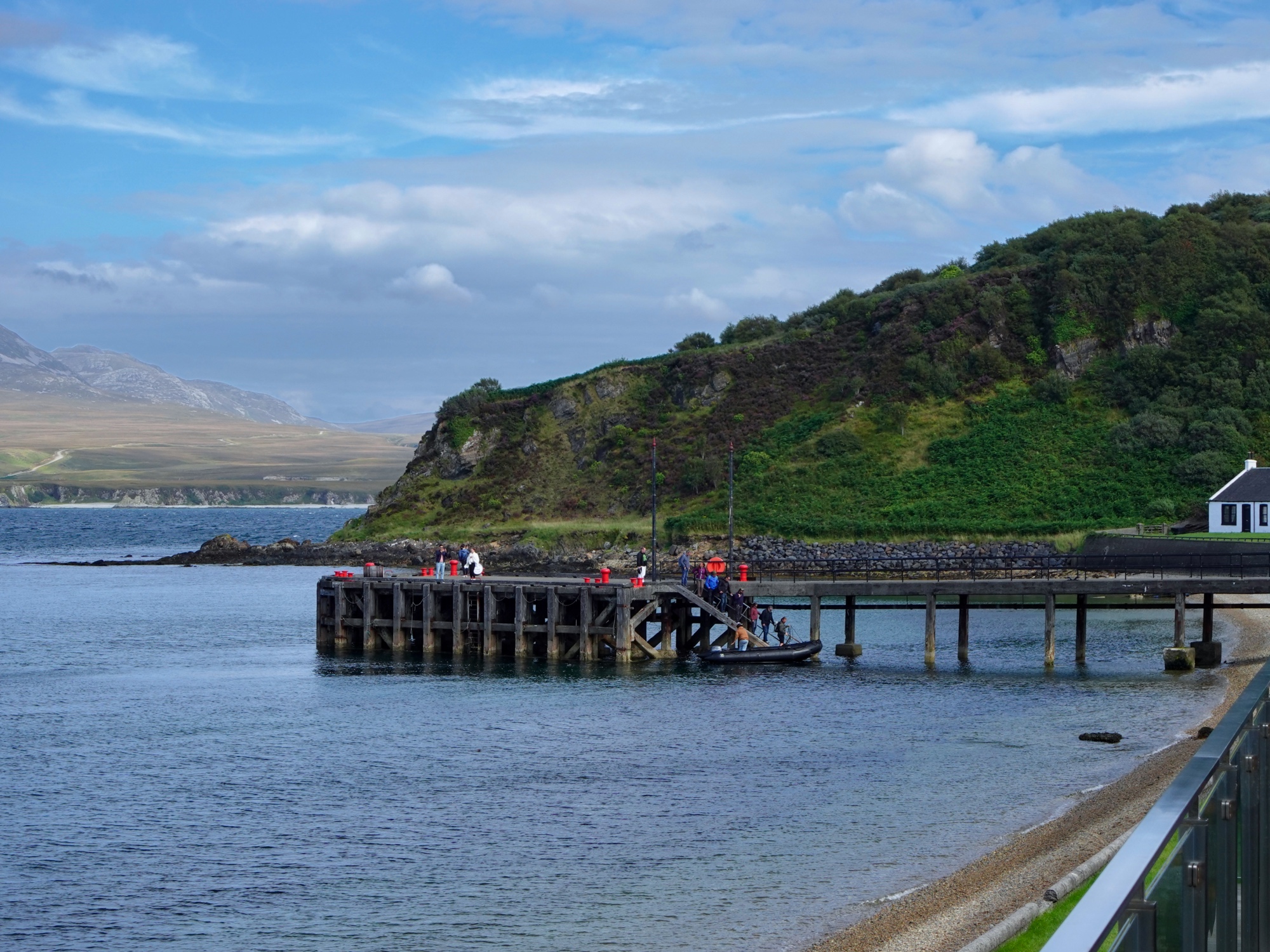After Glasgow and Arran (pt. 1 and 2), my journey took me to Islay for a few days. Time being short, and also wanting to keep some time for our group to explore the island, I had to make some tough choices regarding which distilleries to visit. Due to ongoing work for one distillery and some idiotic policies from another (a story for another occasion), I had to discard my top two choices. So I went to my fellow whisky lovers for advice. While Islay is a peated whisky lover’s dream, the top suggestion was for the one distillery most famous for its unpeated Islay whisky: Bunnahabhain. Out of all the tastings, the Bunnahabhain Warehouse 9 tasting got the most votes by far. But before the tasting, we had to get there.

The most remote distillery on Islay?
I have written about Bunnahabhain’s remoteness in my review of their 12-year-old original bottling. It’s quite something else to drive on the tiny winding single-lane road built in 1960 to connect Bunnahabhain (and now Ardnahoe) to the main road. Once you realise how isolated the distillery was, you fully comprehend why the pier, below, was the only means of communication to the outside world and why it was still used up to 1993. The road is apparently scheduled for an update this winter (2024) so hopefully the drive might become a bit less nerve-wracking than it is today in the future.

Although the Warehouse 9 tasting does not include a tour of Bunnahabhain, we had a chance to see the still room and the most archetypal pear-shaped of all pear-shaped stills and discuss some of the production details with our guide. The 2023 ownership change from Distell to CVH Spirits, following Distell’s acquisition by Heineken, does not seem to have brought major changes to the operations of Bunnahabhain.

There was one thing that raised my eyebrow. Our guide told us the fermentation time at Bunnahabhain is only 48 hours, since, in his words, “the cask provides the flavour”. In a time when craft-minded distilleries are increasing fermentation times to produce wash with more complex aromatic profiles, this seems a bit outside the zeitgeist. Also, according to scotchwhisky.com, which is usually quite reliable for technical details, fermentation is given as 50-100 hours. Guide mistake or production change? Hopefully the former as the latter would likely impact the quality of the spirit.
Eating on Islay: the Oyster shed
Contrary to my other distillery visits, I have no whisky rumour for Bunnahabhain except the well-known upcoming release of the 21-year-old cask strength. So instead I will take the opportunity to provide an eating-out suggestion for Islay: Loch Gruinart’s Islay Oyster Shed.
As with many destinations on Islay, getting here requires a car and a single-lane drive. It is well worth the detour, especially if you are visiting one of the distilleries on the “northern” side of the island and a re looking for a spot for a seafood based lunch.

As the name suggests, the restaurant specialises in locally grown oysters, served raw or fried, in addition to light bites and sandwiches. The oysters alone are worth the stop. These are, without exaggeration, some of the best, if not the best oysters I have ever had. The crab sandwich was pretty tasty too.
If you plan to visit, check the opening times on their Facebook or Instagram profile as these seem to change with the season. In summer 2024 these were Wednesday to Monday from 10 AM to 4 PM.
The Bunnahabhain Warehouse 9 tasting

The Bunnahabhain Warehouse 9 tasting offers participants a chance to try 4 single-cask samples showcasing Bunnahabhain’s best production. The casks change regularly throughout the year based on availability. During my visit, we sampled two unpeated and two peated Bunnahabhains. All the casks are available as hand-filled exclusives in the distillery shop. But more about that is in the section dedicated to the shop.
Below are the notes on the cask samples on my tasting:

2007 Bunnahabhain Distillery hand-filled single cask exclusive 53.7% Aged 10 years in refill cask then finished for 7 years in sweet Muscat wine casks
Pale amber colour. Very elegant on the nose, with a lovely balance of sweet and fresh notes. My tasting notes read vanilla syrup, overripe grapes, orange blossom, sage, red apple, bready, raisins, lemon peel and pith, and toasted almonds. On the palate, it is rich and creamy, with raisins, malted barley, vanilla, pound cake, cooking herbs, ginger, orange blossom and a touch of smoke. The smoke is more barrel char than peat. The finish is all raisins, apples, citrus peel, and herbs, with a slightly bitter and very long finish.
A drop of water makes it even more complex and elegant, with the refill character coming more to the fore with orchard fruit, orange taffy, vanilla and spice and the muscat notes lifting things up a notch with complexity, adding hints of rose petals, liquorice and cinnamon.
By far my favourite dram of the tasting, one I could spend hours with.
2014 Bunnahabhain – Distillery hand-filled single cask exclusive 58.4% 9-year full maturation in Canasta sherry cask.
What is Canasta?
Canasta is a cream sherry made by bodega Williams & Humbert, by sweetening dry oloroso with Pedro Ximénez for a rich and sweet wine. This is then aged in a solera system for at least six years before bottling.
Rich gold colour, not as dark as I would have expected. The nose is intense and definitely on the sweet sherry side. There is an underlying spent matchstick note as a background. While this might put some off, it did not detract from my experience. I jotted down notes of caramel sauce, dried tangerine peel, raisins, figs, dried cherries, chocolate, baking spice, vanilla custard, and toasted nuts. Even for a cask strength dram, it is slightly hot, with a hint of jalapeño spice. On the palate, it is rich and mouthcoating. Again, I found it slightly hot even accounting for the high ABV. I tasted chocolate, figs, dried cherries, baking spice, hazelnuts and toasted almonds, butter, vanilla, oat biscuits and toffee. The finish was long, and nutty, with notes of pastel de nata, dark toffee, figs, and a slight salinity.
Adding water brings those fruity and nutty notes more to the front, both on the nose and palate. Overall this is a lovely sherried dessert whisky.
2011 Bunnahabhain Móine Distillery hand fill exclusive – cask strength 58.9%. 12 year full maturation in second-fill Cognac casks
Pale white wine colour, as you would expect from a second fill cask aged dram. Very “clean” whisky, if that makes any sense. There is a big hit of woody and slightly floral peat, then maritime and bready notes- which together turn into saltines. Then vanilla, some honey, orchard fruits, a hint of aniseed and cumin, and freshly grated lemon peel. On the palate it is peated, as expected, maritime,, vanilla honey orchard fruit, a bit of barley, white pepper, menthol and a slight note of marzipan. The finish is medium in length with notes of orchard fruit, maritime peat, honey and vanilla.
Of all the drams in the tasting, this is the one where water didn’t help open up the aromas, rather it weakened the overall experience. If you have this, I would skip the water.
2013 Bunnahabhain Móine Distillery hand fill exclusive- cask strength 57.9%. Aged 3 years in refill cask then 7 years “finish” in Bordeaux casks.
Coppery amber colour. The red wine cask influence is quite powerful in this one, almost taking over the peaty notes. The nose is peaty and sweet, with notes of woody peat, raspberry jam, cherries, a touch of aniseed and cloves, vanilla, a slight herbaceus note, slightly bready, closing with a hint of ground coffee. The palate is rich and spicy, with raspberry, milk chocolate, peat, ginger and aniseed spice, some malt notes and a touch of rose blossom.The medium long finsih is all red fruit, woody peat, and loads of vanilla,
Water turns the nse significantly more floral and brings out the chocolate notes. On the palate, it becomes more malty and spicier. It is a very enjoyable dram, especially if you like red fruit and peat together, even if it is a bit less complex than the other whiskies in the tasting.
The distillery shop
The one gripe I do have with Bunnahabhain is about their shop. I cannot complain about the selection, which is fantastic. You can find pretty much anything you want. Everything is there, from standard original bottlings to specials, like the Fes Ile releases and the Warehouse 9 hand-filled exclusives. No, my issue is with the prices and the sale of the Warehouse 9 casks.
Let’s start with the prices. I don’t generally expect distillery shops to offer discounts, but if someone takes the time and money to get to the distillery, I would at least hope they could buy at RSP. Instead, Bunnahabhain’s shop offers the standard releases, including older editions like the 25-year-old at a significantly more expensive price (around 15-20% by my calculation) than what I could easily find from specialist providers. Maybe that explains why the distillery shop has so much availability. You are certainly better off buying elsewhere unless you are looking for the distillery exclusives. And I could argue that their prices are not exactly customer-friendly either.
This brings me to the Bunnahabhain Warehouse 9 casks bottlings. I have heard other whisky lovers criticise their pricing as too high. Considering the prices of the other distillery exclusive, I would argue they are almost a good deal. I like less that these are available to anyone stopping at the shop. It would be nice if these were available to those who participate in the tasting, a bit like Cadenehead’s does for their warehouse tasting. Alternatively, stop calling them Warehouse 9 exclusives… because they are not.
Shop issues aside, which are arguably personal, the Bunnahabhain Warehouse 9 tasting is worth the price and the ride to have the opportunity to try some special cask samples. My fellow whisky lovers were spot on.
Up next a “progressive” Islay distillery…
If you have enjoyed this content, please share a comment below and consider supporting the cost of this blog via the button below